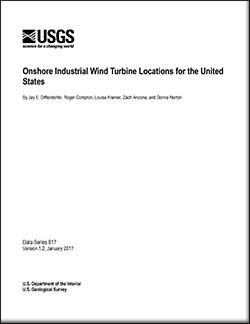 Abstract
Abstract
This dataset provides industrial-scale onshore wind turbine locations in the United States, corresponding facility information, and turbine technical specifications. The database has wind turbine records that have been collected, digitized, locationally verified, and internally quality controlled. Turbines from the Federal Aviation Administration Digital Obstacles File, through product release date July 22, 2013, were used as the primary source of turbine data points. The dataset was subsequently revised and reposted as described in the revision histories for the report. Verification of the turbine positions was done by visual interpretation using high-resolution aerial imagery in Environmental Systems Research Institute (Esri) ArcGIS Desktop. Turbines without Federal Aviation Administration Obstacles Repository System numbers were visually identified and point locations were added to the collection. We estimated a locational error of plus or minus 10 meters for turbine locations. Wind farm facility names were identified from publicly available facility datasets. Facility names were then used in a Web search of additional industry publications and press releases to attribute additional turbine information (such as manufacturer, model, and technical specifications of wind turbines). Wind farm facility location data from various wind and energy industry sources were used to search for and digitize turbines not in existing databases. Technical specifications for turbines were assigned based on the wind turbine make and model as described in literature, specifications listed in the Federal Aviation Administration Digital Obstacles File, and information on the turbine manufacturer’s Web site. Some facility and turbine information on make and model did not exist or was difficult to obtain. Thus, uncertainty may exist for certain turbine specifications. That uncertainty was rated and a confidence was recorded for both location and attribution data quality.
Introduction
A collaboration among U.S. Geological Survey scientists related to energy development and environmental consequences began in 2008. This group anticipated finding accurate information on wind energy facilities and turbines in the public sphere, similar to the types of data available for oil and gas wells. However, turbine information was lacking, and it became apparent that scientists, regulatory agencies, nongovernmental organizations, and other decisionmakers all needed spatially accurate wind turbine information. For example, the U.S. Department of Defense is concerned about wind turbine effects on radar and training areas and the U.S. Fish and Wildlife Service needs turbine location information to fully understand and plan for the effects of wind energy development on federally protected species. This motivated U.S. Geological Survey scientists to map onshore commercial-scale wind turbines nationally with standardized attributes to develop the most up-to-date turbine-level information publicly available. This data series represents that effort. The work is similar to earlier U.S. Geological Survey efforts to map wind turbines at individual states (for example, Carr and others, 2013).
Methods
We developed the wind turbine dataset (Diffendorfer and others, 2014) by synthesizing existing information and combining it with the Federal Aviation Administration’s Digital Obstacles File (DOF) (Federal Aviation Administration, 2013); this dataset was subsequently revised and reposted (Diffendorfer and others, 2015) as described in the report’s revision histories. The DOF describes a wide array of known obstacles to aviators and includes wind turbines. In addition, we used facility information from databases developed by the U.S. Energy Information Administration (U.S. Energy Information Administration, 2013) and the no-longer-maintained Wind Energy Data and Information (WENDI) dataset from Oak Ridge National Laboratory.
High-resolution orthoimagery was used to verify the location of turbines listed in the DOF or to find and digitize turbines not in the DOF. These new turbines were found by searching for facilities listed in other databases. Sets of turbines were assigned to a facility based on matches between turbine counts, aerial photography, industry reports, press articles, and descriptions or maps found in environmental-effect reports and planning documents. Turbine specifications were based on a variety of sources including model-specific lists of turbine dimensions and capacities found at company Web sites. These sources were used in conjunction with site descriptions, planning documents, or information found at the facility owner’s Web site. Quality control and error reduction were based on peer review of the data. All attributes in the database, from the digitized locations of each turbine to the attribute information, were initially entered by one analyst, then error checked and corrected by an independent analyst. Detailed information on our methods and attribute information can be found in the metadata file associated with the data series. We encourage feedback from users of the data so we can enhance its usefulness and quality.
References Cited
Carr, N.B., Diffendorfer, J.E., Fancher, Tammy, Hawkins, S.J., Latysh, Natalie, Leib, K.J., and Matherne, A.M., 2013, Locations and attributes of wind turbines in New Mexico, 2011 [abs.]: U.S. Geological Survey Data Series 783, accessed January 2014 at https://pubs.usgs.gov/ds/783/.
Diffendorfer, J.E., Compton, Roger, Kramer, L.A., Ancona, Zach, and Norton, Donna, 2014, Onshore industrial wind turbine locations for the United States through July 2013: U.S. Geological Survey data release, https://doi.org/10.5066/F7X06561.
Diffendorfer, J.E., Compton, R.W., Kramer, L.A., Ancona, Z.H., and Norton, Donna, 2015, Onshore industrial wind turbine locations for the United States to March 2014: U.S. Geological Survey data release, https://doi.org/10.5066/F7251G8Q.
Federal Aviation Administration, 2013, Digital Obstacles File, in Terrain and Obstacles Data (TOD) Team—Digital Obstacles File (DOF): Federal Aviation Administration, accessed January 2017 at https://www.faa.gov/air_traffic/flight_info/aeronav/digital_products/dof/.
U.S. Energy Information Administration, 2013, Form EIA-860 detailed data, in Electricity: U.S. Energy Information Administration, accessed March 2011 and March 2012 at http://www.eia.gov/electricity/data/eia860/index.html.